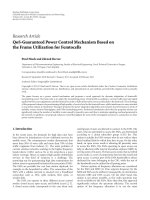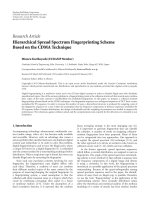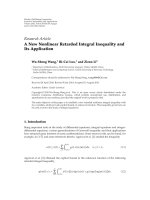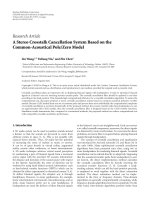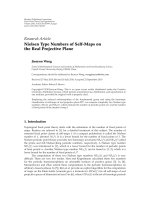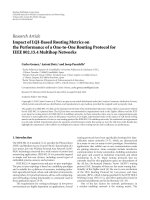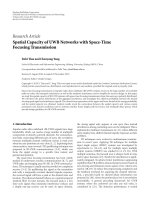Báo cáo hóa học: " Research Article Bounds for Certain Delay Integral Inequalities on Time Scales" potx
Bạn đang xem bản rút gọn của tài liệu. Xem và tải ngay bản đầy đủ của tài liệu tại đây (504.81 KB, 13 trang )
Hindawi Publishing Corporation
Journal of Inequalities and Applications
Volume 2008, Article ID 831817, 13 pages
doi:10.1155/2008/831817
Research Article
Bounds for Certain Delay Integral
Inequalities on Time Scales
Wei Nian Li
1, 2
1
Department of Applied Mathematics, Shanghai Normal University, Shanghai 200234, China
2
Department of Mathematics, Binzhou University, Shandong 256603, China
Correspondence should be addressed to Wei Nian Li,
Received 31 August 2008; Revised 21 October 2008; Accepted 22 October 2008
Recommended by Martin J. Bohner
Our aim in this paper is to investigate some delay integral inequalities on time scales by using
Gronwall’s inequality and comparison theorem. Our results unify and extend some delay integral
inequalities and their corresponding discrete analogues. The inequalities given here can be used as
handy tools in the qualitative theory of certain classes of delay dynamic equations on time scales.
Copyright q 2008 Wei Nian Li. This is an open access article distributed under the Creative
Commons Attribution License, which permits unrestricted use, distribution, and reproduction in
any medium, provided the original work is properly cited.
1. Introduction
The unification and extension of differential equations, difference equations, q-difference
equations, and so on to the encompassing theory of dynamic equations on time scales was
initiated by Hilger 1 in his Ph.D. thesis in 1988. During the last few years, some integral
inequalities on time scales related to certain inequalities arising in the theory of dynamic
equations had been established by many scholars. For example, we refer the reader to
literatures 2–8 and the references therein. However, nobody studied the delay integral
inequalities on time scales, as far as we know. In t his paper, we investigate some delay integral
inequalities on time scales, which provide explicit bounds on unknown functions. Our results
extend some known results in 9.
Throughout this paper, a knowledge and understanding of time scales and time scale
notation is assumed. For an excellent introduction to the calculus on time scales, we refer the
reader to monographes 10, 11.
2. Main results
In what follows, R denotes the set of real numbers, R
0, ∞, Z denotes the set of integers,
N
0
{0, 1, 2, } denotes the set of nonnegative integers, CM, S denotes the class of all
continuous functions defined on set M with range in the set S, T is an arbitrary time scale,
2 Journal of Inequalities and Applications
C
rd
denotes the set of rd-continuous functions, R denotes the set of all regressive and rd-
continuous functions, and R
{p ∈R:1 μtpt > 0, for all t ∈ T}.Weusetheusual
conventions that empty sums and products are taken to be 0 and 1, respectively. Throughout
this paper, we always assume that t
0
∈ T, T
0
t
0
, ∞
T.
The following lemmas are very useful in our main results.
Lemma 2.1 see 9. Assume that p ≥ q ≥ 0,p
/
0, and a ∈ R
. Then
a
q/p
≤
q
p
k
q−p/p
a
p − q
p
k
q/p
, for any k>0. 2.1
Lemma 2.2 Gronwall’s inequality 10. Suppose u, b ∈ C
rd
, m ∈R
, m ≥ 0.Then
ut ≤ bt
t
t
0
mtutΔt, t ∈ T
0
, 2.2
implies
ut ≤ bt
t
t
0
e
m
t, σs
bsmsΔs, t ∈ T
0
. 2.3
Lemma 2.3 comparison theorem 10. Suppose u, b ∈ C
rd
, a ∈R
.Then
u
Δ
t ≤ atutbt,t∈ T
0
, 2.4
implies
ut ≤ u
t
0
e
a
t, t
0
t
t
0
e
a
t, στ
bτΔτ, t ∈ T
0
. 2.5
Firstly, we study the delay integral inequality on time scales of the form
x
p
t ≤ at
t
t
0
bsx
p
sΔs ct
t
t
0
fsx
q
τs
gsx
r
s
Δs, t ∈ T
0
, E
with the initial condition
xtϕt,t∈
α, t
0
∩ T,
ϕ
τt
≤
at
1/p
for t ∈ T
0
with τt ≤ t
0
,
I
where p, q, and r are constants, p
/
0,p≥ q ≥ 0,p≥ r ≥ 0, τ : T
0
→ T,τt ≤ t, −∞<α
inf{τt,t∈ T
0
}≤t
0
, and ϕt ∈ C
rd
α, t
0
∩ T, R
.
Wei Nian Li 3
Theorem 2.4. Assume that xt,at,bt,ct,ft,gt ∈ C
rd
T
0
, R
.Ifat and ct are
nondecreasing for t ∈ T
0
, then the inequality E with the initial condition I implies
xt ≤
e
b
t, t
0
atct
Ft
t
t
0
e
G
t, σs
FsGsΔs
1/p
, 2.6
for any k>0,t∈ T
0
,where
Ft
t
t
0
fs
e
b
s, t
0
q/p
kp − qqas
pk
p−q/p
gs
e
b
s, t
0
r/p
kp − rras
pk
p−r/p
Δs,
2.7
Gtct
qft
e
b
t, t
0
q/p
pk
p−q/p
rgt
e
b
t, t
0
r/p
pk
p−r/p
,t∈ T
0
. 2.8
Proof. Define a function zt by
zt
at
t
t
0
bsx
p
sΔs ct
t
t
0
fsx
q
τs
gsx
r
s
Δs
1/p
,t∈ T
0
. 2.9
It is easy to see that zt is a nonnegative and nondecreasing function, and
xt ≤ zt,t∈ T
0
. 2.10
Therefore,
x
τt
≤ z
τt
≤ zt, for t ∈ T
0
with τt >t
0
. 2.11
On the other hand, using the initial condition I, we have
x
τt
ϕ
τt
≤
at
1/p
≤ zt, for t ∈ T
0
with τt ≤ t
0
. 2.12
Combining 2.11 and 2.12,weobtain
x
τt
≤ zt,t∈ T
0
. 2.13
It follows from 2.9, 2.10,and2.13 that
z
p
t ≤ at
t
t
0
bsz
p
sΔs ct
t
t
0
fsz
q
sgsz
r
s
Δs, t ∈ T
0
. 2.14
Define a function wt by
wtatctut, 2.15
4 Journal of Inequalities and Applications
where
ut
t
t
0
fsz
q
sgsz
r
s
Δs, t ∈ T
0
. 2.16
Then 2.14 can be restated as
z
p
t ≤ wt
t
t
0
bsz
p
sΔs, t ∈ T
0
. 2.17
Obviously, w ∈ C
rd
T
0
, R
,bt ≥ 0,b∈R
.UsingLemma 2.2,from2.17,weobtain
z
p
t ≤ wt
t
t
0
e
b
t, σs
wsbsΔs, t ∈ T
0
. 2.18
Noting that wt is nondecreasing, from 2.18, we have
z
p
t ≤ wtwt
t
t
0
e
b
t, σs
bsΔs wt
1
t
t
0
e
b
t, σs
bsΔs
,t∈ T
0
.
2.19
By 10, Theorems 2.39 and 2.36i,weobtain
t
t
0
e
b
t, σs
bsΔs e
b
t, t
0
− e
b
t, te
b
t, t
0
− 1,t∈ T
0
. 2.20
It follows from 2.19 and 2.20 that
z
p
t ≤ wte
b
t, t
0
e
b
t, t
0
atctut
,t∈ T
0
. 2.21
Using Lemma 2.1,from2.21, for any k>0, we easily obtain
z
q
t ≤
e
b
t, t
0
q/p
atctut
q/p
≤
e
b
t, t
0
q/p
kp − qqat
pk
p−q/p
qctut
pk
p−q/p
,t∈ T
0
,
2.22
z
r
t ≤
e
b
t, t
0
r/p
atctut
r/p
≤
e
b
t, t
0
r/p
kp − rrat
pk
p−r/p
rctut
pk
p−r/p
,t∈ T
0
.
2.23
Wei Nian Li 5
Combining 2.16, 2.22,and2.23, we have
ut ≤
t
t
0
fs
e
b
s, t
0
q/p
kp − qqas
pk
p−q/p
qcsus
pk
p−q/p
gs
e
b
s, t
0
r/p
kp − rras
pk
p−r/p
rcsus
pk
p−r/p
Δs
Ft
t
t
0
GsusΔs, t ∈ T
0
,
2.24
where Ft and Gt are defined by 2.7 and 2.8, respectively. Using Lemma 2.2,from
2.24, we have
ut ≤ Ft
t
t
0
e
G
t, σs
FsGsΔs, t ∈ T
0
. 2.25
Therefore, the desired inequality 2.6 follows from 2.10, 2.22,and2.25. This completes
the proof.
Theorem 2.5. Suppose that all assumptions of Theorem 2.4 hold. Then the inequality E with the
initial condition I implies
xt ≤
e
b
t, t
0
atctFte
G
t, t
0
1/p
, 2.26
for any k>0,t∈ T
0
,whereFt and Gt are defined by 2.7 and 2.8, respectively.
Proof. As in the proof of Theorem 2.4,weobtain2.25. It is easy to see that Ft is
nondecreasing for t ∈ T
0
. Therefore, by 10, Theorems 2.39 and 2.36i, we have
ut ≤ Fte
G
t, t
0
,t∈ T
0
. 2.27
The desired inequality 2.26 follows from 2.10, 2.22,and2.27. The proof is complete.
Remark 2.6. Let T R.Ifbt0, then Theorem 2.5 reduces to 9, Theorem 2.3. Letting T Z,
from Theorem 2.5, we easily establish the following result.
Corollary 2.7. Assume that xn,an,bn,cn,fn,gn are nonnegative functions defined
for n ∈ N
0
.Ifan and cn are nondecreasing in N
0
, and xn satisfies the following delay discrete
inequality:
x
p
n ≤ an
n−1
s0
bsx
p
scn
n−1
s0
fsx
q
s − ρgsx
r
s
,n∈ N
0
, E1
6 Journal of Inequalities and Applications
with the initial condition
xnϕn,n∈{−ρ, ,−1, 0},
ϕn − ρ ≤
an
1/p
for n ∈ N
0
with n − ρ ≤ 0,
I1
where p, q, r, and ρ are constants, p
/
0,p≥ q ≥ 0,p≥ r ≥ 0, ρ ∈ N
0
, ϕn ∈ R
,n∈
{−ρ, ,−1, 0}, then
xn ≤
n−1
s0
1 bs
ancnHn
n−1
s0
1 Js
1/p
, 2.28
for any k>0,n∈ N
0
,
Hn
n−1
s0
fs
s−1
t0
1 bt
q/p
kp − qqas
pk
p−q/p
gs
s−1
t0
1 bt
r/p
kp − rras
pk
p−r/p
,
Jncn
qfn
n−1
s0
1 bs
q/p
pk
p−q/p
rgn
n−1
s0
1 bs
r/p
pk
p−r/p
,n∈ N
0
.
2.29
Next, using the Chain Rule, we consider a special case of the delay integral inequality
E of the form
x
p
t ≤ C
t
t
0
bsx
p
sΔs
t
t
0
fsx
p−1
τs
Δs, t ∈ T
0
, E
with the initial condition
xtϕt,t∈
α, t
0
∩ T,
ϕ
τt
≤ C
1/p
for t ∈ T
0
with τt ≤ t
0
,
I
where C and p ≥ 1 are positive constants, τt, α,andϕt are defined as in I.
Theorem 2.8. Assume that xt,bt,ft ∈ C
rd
T
0
, R
. Then the inequality E
with the initial
condition I
implies
xt ≤ C
1/p
e
b/p
t, t
0
1
p
t
t
0
e
b/p
t, σs
fsΔs, t ∈ T
0
. 2.30
Wei Nian Li 7
Proof. Define a function wt by
w
p
tC
t
t
0
bsx
p
sΔs
t
t
0
fsx
p−1
τs
Δs, t ∈ T
0
. 2.31
Using a similar way in the proof of Theorem 2.4, we easily obtain that wt is a positive
and nondecreasing function, and
xt ≤ wt,t∈ T
0
, 2.32
x
τt
≤ wt,t∈ T
0
. 2.33
Differentiating 2.31,weobtain
pw
p−1
θw
Δ
tbtx
p
tftx
p−1
τt
,t∈ T
0
, 2.34
where θ ∈ t, σt.
It follows from 2.32–2.34 that
pw
p−1
θw
Δ
t ≤ btw
p
tftw
p−1
t,t∈ T
0
. 2.35
Noting the fact that 0 <wt ≤ wθ and w
Δ
t ≥ 0, from the above inequality, we have
pw
p−1
tw
Δ
t ≤ btw
p
tftw
p−1
t,t∈ T
0
. 2.36
Therefore,
w
Δ
t ≤
bt
p
wt
ft
p
,t∈ T
0
. 2.37
By Lemma 2.3,from2.37, we have
wt ≤ C
1/p
e
b/p
t, t
0
t
t
0
e
b/p
t, σs
fs
p
Δs, t ∈ T
0
. 2.38
Therefore, the desired inequality 2.30 follows from 2.32 and 2.38. This completes the
proof of Theorem 2.8.
Corollary 2.9. Assume that xt,bt,ft ∈ CR
, R
.Ifxt satisfies the following delay integral
inequality:
x
p
t ≤ C
t
0
bsx
p
sds
t
0
fsx
p−1
ρs
ds, t ∈ R
, E2
8 Journal of Inequalities and Applications
with the initial condition
xtφt,t∈ β, 0,
φ
ρt
≤ C
1/p
for t ∈ R
with ρt ≤ 0,
I2
where C and p ≥ 1 are positive constants, ρt ∈ CR
, R,ρt ≤ t, −∞<β inf{ρt,t∈ R
}≤
0, and φt ∈ Cβ, 0, R
, then
xt ≤ C
1/p
exp
t
0
bs
p
ds
1
p
t
0
fs exp
t
s
bτ
p
dτ
ds, t ∈ R
. 2.39
Corollary 2.10. Assume that xn,bn,fn are nonnegative functions defined for n ∈ N
0
.If
xn satisfies the following delay discrete inequality:
x
p
n ≤ C
n−1
s0
bsx
p
s
n−1
s0
fsx
p−1
s − ρ,n∈ N
0
, E3
with the initial condition
xnϕn,n∈{−ρ, ,−1, 0},
ϕn − ρ ≤ C
1/p
for n ∈ N
0
with n − ρ ≤ 0,
I3
where C and p ≥ 1 are positive constants, ρ and ϕn are defined as in I1,then
xn ≤ C
1/p
n−1
s0
1
bs
p
1
p
n−1
s0
fs
n−1
is1
1
bi
p
,n∈ N
0
. 2.40
Finally, we study the delay integral inequality on time scales of the form
x
p
t ≤ atct
t
t
0
fsx
q
sL
s, x
τs
Δs, t ∈ T
0
, E
with the initial condition I, where p ≥ 1, 0 ≤ q ≤ p are constants, τt is as defined in the
inequality E,andL : T
0
× R
→ R
is a continuous function.
Theorem 2.11. Assume that xt,at,ct,ft ∈ C
rd
T
0
, R
.Ifat and ct are nondecreasing
for t ∈ T
0
, and
0 ≤ Lt, x − Lt, y ≤ Kt, yx − y, 2.41
Wei Nian Li 9
for x ≥ y ≥ 0,whereK : T
0
× R
→ R
is a continuous function, then the inequality E
with the
initial condition I implies
xt ≤
atct
Ht
t
t
0
e
J
t, σs
HsJsΔs
1/p
, 2.42
for any k>0,t∈ T
0
,where
Ht
t
t
0
fs
kp − qqas
pk
p−q/p
L
s,
p − 1
p
as
p
Δs, 2.43
Jt
qctft
pk
p−q/p
K
t,
p − 1
p
at
p
ct
p
. 2.44
Proof. Define a function zt by
zt
t
t
0
fsx
q
sL
s, x
τs
Δs, t ∈ T
0
. 2.45
We easily observe that zt is a nonnegative and nondecreasing function, and E
can be
restated as
xt ≤
atctzt
1/p
,t∈ T
0
. 2.46
Using Lemma 2.1,from2.46, we have
xt ≤
atctzt
1/p
≤
p − 1
p
at
p
ctzt
p
,t∈ T
0
. 2.47
Therefore, for t ∈ T
0
with τt ≥ t
0
,weobtain
x
τt
≤
p − 1
p
a
τt
p
c
τt
z
τt
p
≤
p − 1
p
at
p
ctzt
p
, 2.48
and for t ∈ T
0
with τt ≤ t
0
, using the initial condition I and 2.47,weget
x
τt
ϕ
τt
≤
at
1/p
≤
p − 1
p
at
p
ctzt
p
. 2.49
10 Journal of Inequalities and Applications
It follows from 2.48 and 2.49 that
x
τt
≤
p − 1
p
at
p
ctzt
p
,t∈ T
0
. 2.50
Combining 2.45, 2.46,and2.50,byLemma 2.1, for any k>0, we obtain
zt ≤
t
t
0
fs
ascszs
q/p
Δs
t
t
0
L
s,
p − 1
p
as
p
cszs
p
Δs
≤
t
t
0
fs
kp − qqas
pk
p−q/p
qcszs
pk
p−q/p
Δs
t
t
0
L
s,
p − 1
p
as
p
cszs
p
− L
s,
p − 1
p
as
p
L
s,
p − 1
p
as
p
Δs
≤
t
t
0
fs
kp − qqas
pk
p−q/p
L
s,
p − 1
p
as
p
Δs
t
t
0
qcsfs
pk
p−q/p
K
s,
p − 1
p
as
p
cs
p
zsΔs
Ht
t
t
0
JszsΔs, t ∈ T
0
,
2.51
where Ht and Jt are defined by 2.43 and 2.44, respectively.
By Lemma 2.2,from2.51, we have
zt ≤ Ht
t
t
0
e
J
t, σs
HsJsΔs, t ∈ T
0
. 2.52
Therefore, the desired inequality 2.42 follows from 2.46 and 2.52. The proof of
Theorem 2.11 is complete.
Noting Ht, defined by 2.43, is nondecreasing for t ∈ T
0
, we easily obtain the
following result.
Theorem 2.12. Suppose that all assumptions of Theorem 2.11 hold. Then the inequality E
with
the initial condition I implies
xt ≤
atctHte
J
t, t
0
1/p
, 2.53
for any k>0,t∈ T
0
,whereHt and Jt are defined by 2.46 and 2.47, respectively.
Remark 2.13. If T R, then Theorem 2.12 reduces to 9, Theorem 2.8. Letting T Z,from
Theorem 2.12, we can obtain the following corollary.
Wei Nian Li 11
Corollary 2.14. Assume that xn,an,cn,fn are nonnegative functions defined for n ∈ N
0
.
If an and cn are nondecreasing in N
0
, and xn satisfies the following delay discrete inequality:
x
p
n ≤ ancn
n−1
s0
fsx
q
sL
s, xs − ρ
,n∈ N
0
, E4
where p, q, and ρ are constants, p ≥ 1,p≥ q ≥ 0,ρ∈ N
0
, and L, K : N
0
× R
→ R
satisfying
0 ≤ Ln, x − Ln, y ≤ Kn, yx − y, 2.54
for x ≥ y ≥ 0, then the inequality E4 with the initial condition I1 implies
xn ≤
ancn
Hn
n−1
s0
1
Js
1/p
, 2.55
for any k>0,n∈ N
0
,where
Hn
n−1
s0
fs
kp − qqas
pk
p−q/p
L
s,
p − 1
p
as
p
,
Jn
qcnfn
pk
p−q/p
K
n,
p − 1
p
an
p
cn
p
.
2.56
3. Some applications
In this section, we present some applications of our results.
Example 3.1. Consider the delay dynamic equation on time scales:
x
p
t
Δ
Mt, xt,xτt,t∈ T
0
, 3.1
with the initial condition
xtψt,t∈
α, t
0
∩ T,
ψ
τt
C
1/p
for t ∈ T
0
with τt ≤ t
0
,
I
where M : T
0
× R
2
→ R is a continuous function, C x
p
t
0
and p>0 are constants, α and
τt are as defined in the initial condition I,andψt ∈ C
rd
α, t
0
∩ T, R.
Theorem 3.2. Assume that
M
t, xt,x
τt
≤ ft
x
q
τt
gt
x
r
t
, 3.2
12 Journal of Inequalities and Applications
where ft,gt ∈ C
rd
T
0
, R
, q and r are constants, p ≥ q ≥ 0,p≥ r ≥ 0.Ifxt is a solution of
3.1 satisfying the initial condition I
,then
xt
≤
|C|
Ft
t
t
0
e
G
t, σs
FsGsΔs
1/p
, 3.3
for any k>0,t∈ T
0
,where
Ft
t
t
0
fs
kp − qq|C|
pk
p−q/p
gs
kp − rr|C|
pk
p−r/p
Δs, 3.4
Gt
qft
pk
p−q/p
rgt
pk
p−r/p
. 3.5
Proof. Obviously, the solution xt of 3.1 with the initial condition I
satisfies the
equivalent delay integral equation on time scales
x
p
tC
t
t
0
M
s, xs,x
τs
Δs, t ∈ T
0
, 3.6
with the initial condition I
. Noting the assumption 3.2, we have
x
p
t
≤|C|
t
t
0
fs
x
q
τs
gs
x
r
s
Δs, t ∈ T
0
, 3.7
with the initial condition I
. Therefore, by Theorem 2.4,from3.7, we easily obtain the
estimate 3.3 of solutions of 3.1. The proof of Theorem 3.2 is complete.
Using Theorem 2.5, we easily obtain the following result.
Theorem 3.3. Suppose that all assumptions of Theorem 3.2 hold. If xt is a solution of 3.1
satisfying the initial condition I
,then
xt
≤
|C|
Fte
G
t, t
0
1/p
, 3.8
for any k>0,t∈ T
0
,whereFt and Gt are defined by 3.4 and 3.5, respectively.
Remark 3.4. The right-hand sides of 3.3 and 3.8 give us the bounds on the solution xt of
3.1 satisfying the initial condition I
in terms of the known functions for any k>0,t∈ T
0
,
respectively.
Example 3.5. Consider the delay discrete inequality as in E3 satisfying the initial condition
I3 with p 2, C 1/4, ρ 2, ϕn1/2, n ∈{−2, −1, 0}, bn10
−3
n
2
, fn10
−4
n,
n ∈ N
0
, and we compute the values of xn from E3 and also we find the values of xn by
using the result 2.40. In our computations, we use E3 and 2.40 as equations and as we
see in Table 1 the computation values as in E3 are less than the values of the result 2.40.
Wei Nian Li 13
Tab le 1
n E32.43
15.000000000000000e–001 5.000000000000000e–001
35.013992421214853e–001 5.014006000000000e–001
75.240341550720497e–001 5.242013057437409e–001
11 6.053588145272404e–001 6.073138820474305e–001
14 7.428258989476674e–001 7.507097542821271e–001
17 1.009578705314619e000 1.036912536372208e000
22 2.189862704124656e000 2.391160696569409e000
25 4.143517993238956e000 4.841349883598182e000
27 6.839504919933415e000 8.504988064333858e000
30 1.630102753510524e001 2.295320353713791e001
35 9
.500824036460114e001 1.816014350966817e002
40 8.204195033362939e002 2.464464322608679e003
From Table 1, we easily find that the numerical solution agrees with the analytical solu-
tion for some discrete inequalities. The program is written in the programming Matlab 7.0.
Acknowledgments
The author thanks the referee very much for his careful comments and valuable suggestions
on this paper. This work is supported by the Natural Science Foundation of Shandong
Province Y2007A08, the National Natural Science Foundation of China 60674026,
10671127, the Project of Science and Technology of the Education Department of Shandong
Province J08LI52, and the Doctoral Foundation of Binzhou University 2006Y01.
References
1 S. Hilger, “Analysis on measure chains—a unified approach to continuous and discrete calculus,”
Results in Mathematics, vol. 18, no. 1-2, pp. 18–56, 1990.
2 R. Agarwal, M. Bohner, and A. Peterson, “Inequalities on time scales: a survey,” Mathematical
Inequalities & Applications, vol. 4, no. 4, pp. 535–557, 2001.
3 E. Akin–Bohner, M. Bohner, and F. Akin, “Pachpatte inequalities on time scales,” Journal of Inequalities
in Pure and Applied Mathematics, vol. 6, no. 1, article 6, pp. 1–23, 2005.
4 W. N. Li, “Some new dynamic inequalities on time scales,” Journal of Mathematical Analysis and
Applications, vol. 319, no. 2, pp. 802–814, 2006.
5 F H. Wong, C C. Yeh, and C H. Hong, “Gronwall inequalities on time scales,” Mathematical
Inequalities & Applications, vol. 9, no. 1, pp. 75–86, 2006.
6 W. N. Li and W. Sheng, “Some nonlinear dynamic inequalities on time scales,” Proceedings of the Indian
Academy of Sciences. Mathematical Sciences, vol. 117, no. 4, pp. 545–554, 2007.
7 W. N. Li and W. Sheng, “Some nonlinear integral inequalities on time scales,” Journal of Inequalities
and Applications, vol. 2007, Article ID 70465, 15 pages, 2007.
8 D. R. Anderson, “Dynamic double integral inequalities in two independent variables on time scales,”
Journal of Mathematical Inequalities, vol. 2, no. 2, pp. 163–184, 2008.
9 F. Jiang and F. Meng, “Explicit bounds on some new nonlinear integral inequalities with delay,”
Journal of Computational and Applied Mathematics, vol. 205, no. 1, pp. 479–486, 2007.
10 M. Bohner and A. Peterson, Dynamic Equations on Time Scales: An Introduction with Applications,
Birkh
¨
auser, Boston, Mass, USA, 2001.
11 M. Bohner and A. Peterson, Eds., Advances in Dynamic Equations on Time Scales,Birkh
¨
auser, Boston,
Mass, USA, 2003.

